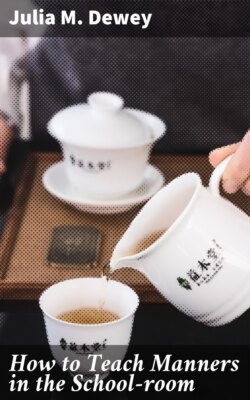Читать книгу How to Teach Manners in the School-room - Julia M. Dewey - Страница 9
На сайте Литреса книга снята с продажи.
Chapter II. LESSONS ON MANNERS.
ОглавлениеTable of Contents
LESSON I.
For the Youngest Pupils.
Purpose.—To awaken an interest in manners in general.
Method.—A common incident in real life briefly described, followed by questions and answers.
The Lesson.
As I was sitting on the piazza the other evening, watching the sunset and listening to the chirp of the birds, a boy passed along the sidewalk, and as he looked up and saw me, he touched his hat and smiled and said, “Good evening, Miss B.” I smiled back and answered him, and as he passed on I thought about him. Why did I think about him?
“Because he was so pleasant to you.”
Can you tell what I thought?
“You thought he was good.”
“You thought he was a nice boy.”
Why did I think so?
“Because he touched his hat.”
“Because he smiled.”
“Because he said, ‘Good evening, Miss B.’”
Yes, because he was polite to me. Can you tell why we should be polite?
“It makes people think of us.”
“It makes people like us.”
What must we learn, then, if we wish people to like us?
“To be polite.”
LESSON II.
Purpose.—To suggest kindness as an element of politeness.
Method.-A supposed incident is used, and questions given.
The Lesson.
Suppose a new little girl should come into our room. Perhaps she would come from a country far away from this place. Her dress might be queer, and she might not look like any other little girl in the room. What do you think these boys and girls would do?
“Look at her.”
Oh, I hope not, for how would she feel?
“I guess she wouldn’t like it.”
“I think she would be scared.”
“Perhaps she would cry.”
If she should speak in her own way, not like ours, what would happen then?
“Like enough we should laugh.”
Oh, no, I hope not.
“I should feel sorry for her.”
What would you do for her, May?
“I would go and stand by her and speak to her.”
What would you say?
“Please come and sit with me.”
What would you say of May, children, if she should do and say what she thinks she would?
“That she is a good girl.”
“She is a kind girl.”
“And a polite girl.”
What would you say of those children who stared and laughed at her?
“They were not kind.”
“They were not polite.”
What do you mean by politeness?
“It is to speak kind words.”
“And to do kind acts.”
Yes. I will tell you what it is, in a pretty verse:
“Politeness is to do and say
The kindest thing in the kindest way.”
Note.—This couplet is to be memorized.
LESSON III.
Purpose.—To suggest seeking the happiness of others as an element of good manners.
Method.—A story told founded on an incident liable to happen at any time, and a conversation deduced.
The Lesson.
One day I looked out on the play-ground, where there were many children playing and seeming to have the best kind of a time. On the other side of the ground was one little girl looking as sad and lonely as you can think. I was about to go and see if I could cheer her up, when another little girl whose name was Jennie, and who had been playing with all her might, happened to see her. She left her place and went to the stranger, and said in a sweet way, “Wouldn’t you like to come and play too? Come and take my place.” And away they went hand-in-hand, looking as happy as two butterflies.
Now, what do you think of Jennie?
“She was good.”
“She was kind.”
“She asked the new girl to go and play.”
Was that all?
“She gave up her place in the game that the little girl might play.”
Was that very kind?
“Yes, Miss B.”
How did it make the little stranger feel?
“Happy.”
What do you say of such acts?
“They are polite.”
How, then, shall we be polite to others?
“By trying to make them happy.”
Note.—Although all the underlying principles of politeness can be taught unconsciously to the youngest pupils, it is better to teach but two formally, without unfamiliar terms. The end sought in the first year of instruction in this subject is to rouse thought and interest, and to lead the pupil to make simple judgments. In the next higher grade of lessons, other principles may be formally taught, and new terms brought out. In the highest grade all principles should be taught.
